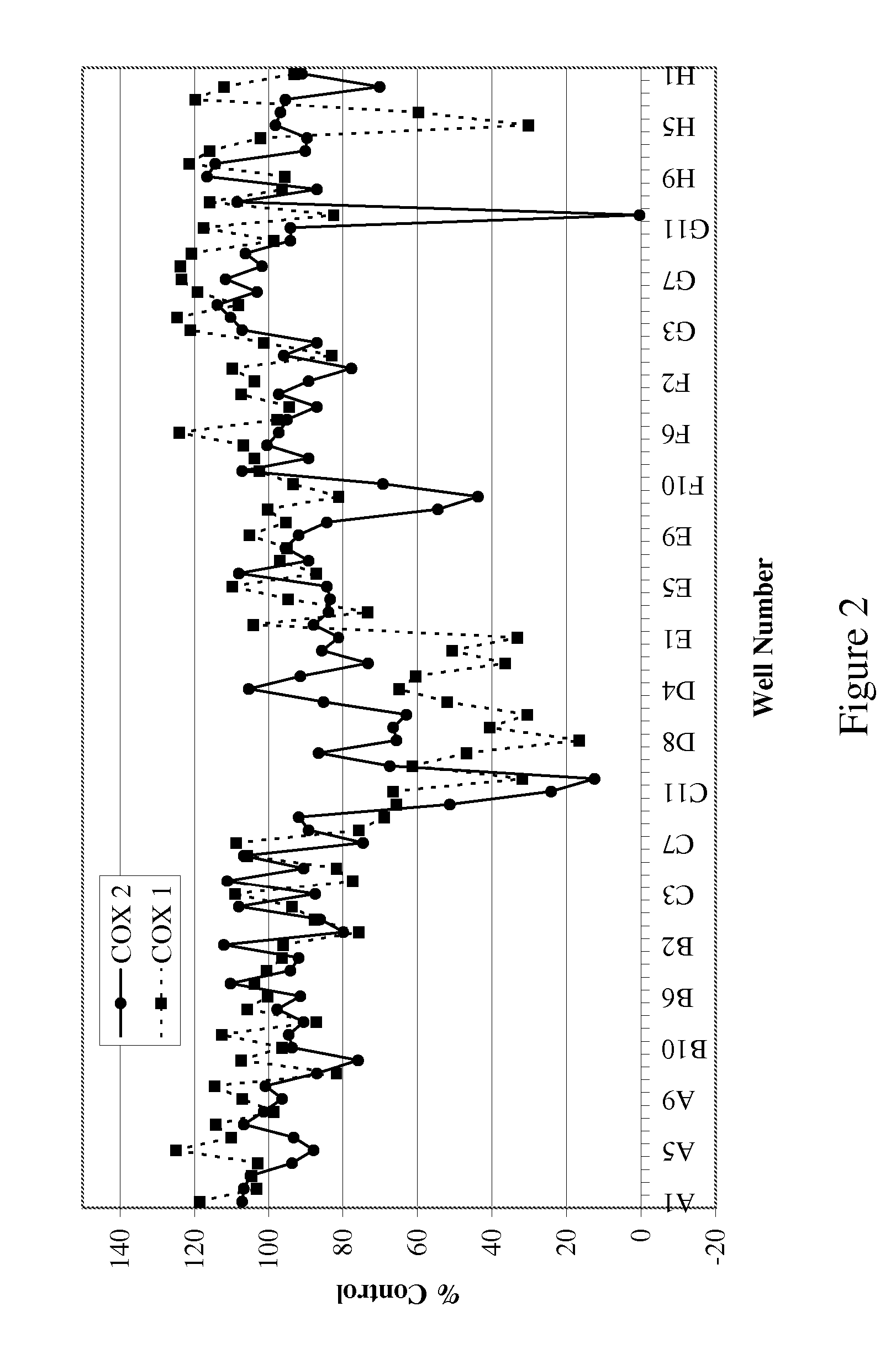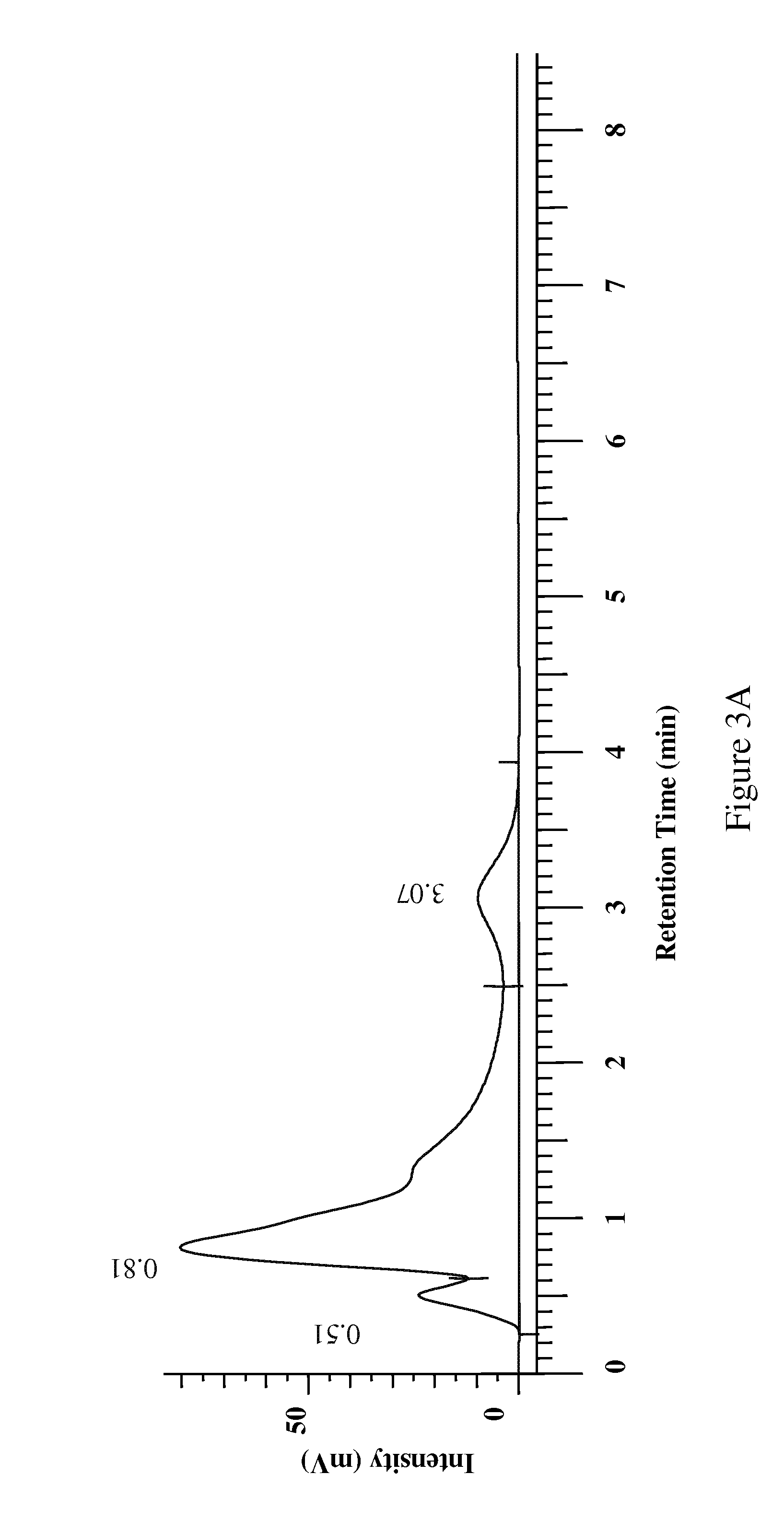Isolation of a Dual Cox-2 and 5-Lipoxygenase Inhibitor from Acacia
a cox-2 and acacia technology, applied in the field of cox-2 and 5lipoxygenase inhibitors, can solve the problems of contributing to a significant amount of gastric epithelial injury
- Summary
- Abstract
- Description
- Claims
- Application Information
AI Technical Summary
Benefits of technology
Problems solved by technology
Method used
Image
Examples
example 1
Preparation of Organic and Aqueous Extracts from Acacia catechu
[0080] Plant material from Acacia catechu (L) Willd was ground to a particle size no larger than 2 mm. Dried ground plant material (60 g) was then transferred to an Erlenmeyer flask and methanol:dichloromethane (1:1) (600 mL) was added. The mixture was shaken for one hour, filtered and the biomass was extracted again with methanol:dichloromethane (1:1) (600 mL). The organic extracts were combined and evaporated under vacuum to provide the organic extract (see Table 1 below). After organic extraction, the biomass was air dried and extracted once with ultra pure water (600 mL). The aqueous solution was filtered and freeze-dried to provide the aqueous extract.
TABLE 1Yield of Organic and Aqueous Extracts of Acacia catechuPlant SourceAmountOrganic ExtractAqueous ExtractAcacia catechu60 g27.2 g10.8 g
example 2
Inhibition of COX-2 and COX-1 Peroxidase Activity by Plant Extracts from Acacia catechu
[0081] The bioassay directed screening process for the identification of specific COX-2 inhibitors was designed to assay the peroxidase activity of the enzyme as described below.
[0082] Peroxidase Assay. The assay to detect inhibitors of COX-2 was modified for a high throughput platform (Raz and Needleman (1990) J. Biol. Chem. 269:603-607). Briefly, recombinant ovine COX-2 (Cayman) in peroxidase buffer (100 mM, TBS, 5 mM EDTA, 1 μM Heme, 0.01 mg epinephrine, 0.094% phenol) was incubated with the extract (1:500 dilution) for 15 minutes. Quantablu (Pierce) substrate was added and allowed to develop for 45 minutes at 25° C. Luminescence was then read using a Wallac Victor 2 plate reader. The results are set forth in Table 2. The data in Table 2 is presented as the percent of peroxidase activity relative to the recombinant ovine COX-2 enzyme and substrate alone. The percent inhibition ranged from 30%...
example 3
HTP Fractionation of Active Extracts
[0084] The organic extract (400 mg) from Acacia catechu was loaded onto a prepacked flash column. (2 cm ID×8.2 cm, 10 g silica gel). The column was eluted using an Hitachi high throughput purification (HTP) system with a gradient mobile phase of (A) 50:50 EtOAc:hexane and (B) methanol from 100% A to 100% B in 30 minutes at a flow rate of 5 mL / min. The separation was monitored using a broadband wavelength UV detector and the fractions were collected in a 96-deep-well plate at 1.9 mL / well using a Gilson fraction collector. The sample plate was dried under low vacuum and centrifugation. DMSO (1.5 mL) was used to dissolve the samples in each cell and a portion (100 μL) was taken for the COX inhibition assay.
[0085] The aqueous extract (750 mg) from Acacia catechu was dissolved in water (5 mL), filtered through a 1 μm syringe filter and transferred to a 4 mL HPLC vial. The mixture was then injected by an autosampler onto a prepacked reverse phase colu...
PUM
| Property | Measurement | Unit |
|---|---|---|
| particle size | aaaaa | aaaaa |
| flow rate | aaaaa | aaaaa |
| particle size | aaaaa | aaaaa |
Abstract
Description
Claims
Application Information
 Login to View More
Login to View More - R&D
- Intellectual Property
- Life Sciences
- Materials
- Tech Scout
- Unparalleled Data Quality
- Higher Quality Content
- 60% Fewer Hallucinations
Browse by: Latest US Patents, China's latest patents, Technical Efficacy Thesaurus, Application Domain, Technology Topic, Popular Technical Reports.
© 2025 PatSnap. All rights reserved.Legal|Privacy policy|Modern Slavery Act Transparency Statement|Sitemap|About US| Contact US: help@patsnap.com



